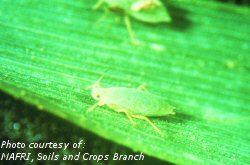Aphids

Aphids

Aphids
Host Plants and Distribution
There are many species of aphids found in Canada and the northern United States. Many are host specific and many feed on a variety of host plants. In general, they are monitored and controlled in the same manner. The exception is the woolly elm aphid, which is treated separately. Other aphid species will feed on chokecherry, saskatoon, raspberry and strawberry.
Biology
Aphids are small, soft-bodied insects with complex life cycles. Most often they are pale green in colour but vary from black to red to green. Aphids either overwinter as eggs or migrate in on wind currents from the south. The life cycle may involve more than one host species. Aphids are the only insects that give birth to live young. Reproduction may be asexual or sexual. The first aphids appear in May and several generations are produced over the summer. Aphids may be winged or wingless.
Symptoms and Damage
Aphids feed by piercing plant tissue and sucking out plant juices, primarily from shoots and leaves. Feeding damage may lead to wilting or leaf distortion. Only when aphid populations are extremely high does damage result from direct aphid feeding. Chokecherry aphids are most commonly found on seedlings in nurseries. They cause leaves to cup and curl with colonies of aphids located on the underside of leaves. In strawberries, high populations of aphids can lead to mold growing on berries as a result of honeydew deposited on the berries by the aphids. Aphids also transmit viruses in strawberries, although this is more of a concern in transplant production, and there is little evidence that the spread of virus can be reduced by controlling aphid populations. In raspberry production, aphids also transmit viruses (raspberry mosaic, raspberry leaf curl) and are most damaging to nursery production. Viruses are best managed by using virus-tolerant varieties and certified plantings.
Scouting Techniques
Aphid infestations are usually clumped in their distribution. High populations develop when the weather is warm and humidity is high. Plants should be visually inspected early in the summer (May and June) to determine numbers present. Later in the season, after fruiting is complete, only very high numbers of aphids will require control measures.
Economic Thresholds
The only economic thresholds available are for raspberry. Control measures should be applied if more than two aphids per cane tip are detected. In other crops the number of aphids per plant required to cause economic damage is quite high( >15/plant). Remember that aphids occur in clumps, and control measures may not need to be applied to the entire field.
Cultural Control
High numbers of aphids are required before damage will occur. Aphids are susceptible to attack by a wide variety of predatory and parasitic insects. As such, the choice to use insecticides must bear in mind the effect on the insects attacking the aphids, as they will also be killed. Aphids are also susceptible to the effects of weather. Heavy rains and periods of high temperature will negatively affect population levels.

